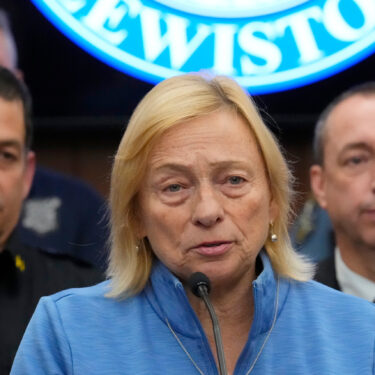Even before the first AP alert went out, Sharp and Robert Bukaty were headed to Lewiston, where a gunman had opened fire in a bowling area and bar and then vanished into the night. They were the first national news crew to arrive, coming up live for video and filing the first images of the aftermath.
Sharp’s video interview with a shoeless man who hid in the machinery of the bowling alley as people died around him was among the first eyewitness accounts, getting wide usage by clients including The New York Times.
Ultimately, 18 people would die, and residents would stay locked inside their homes for days.
Patrick Whittle in Portland was on the case from the start, activating his sources to learn about the manhunt’s progress. Others around in the region were there, too, including Mike Casey, Lisa Rathke and Kathy McCormack. Holly Ramer was reporting and writing for her haunting narrative “Moments of Terror.”
Throughout the following days, a crew of journalists shared responsibilities in Lewiston, including Sharp, Bukaty, Steven Senne, Rodrique Ngowi, Robert Bumsted, Michelle Smith, David R. Martin, Matt Rourke, Matt York, Jessie Wadarski and Jake Bleiberg.
Mike Balsamo, Alanna Durkin Richer and Lindsay Whitehurst from the law enforcement team provided background and law enforcement sources to keep us competitive and accurate, including work that prevented AP from making a major mistake that nearly every other news organization made about the number of people killed.
As the search continued, the breaking news investigations team of Bernard Condon and Jim Mustian exclusively reported that Maine police were alerted as recently as September to “veiled threats” by the U.S. Army reservist.
Condon and Mustian were also first to report that, despite those threats and the alert, Robert Card had not been on the FBI’s radar and had received no information that would have prevented him from buying a weapon.
AP’s story, which was matched — with credit — over the next day by both The New York Times and CNN, marked the most detailed reporting yet on the contact law enforcement had with the gunman, who killed himself.
And the discovery of the suspect’s body did not slow down the trajectory of the story — frightened residents emerged from their homes to mourn, and AP stayed to bear witness for a global audience.
The AP hit 9 million views on Thursday, a surge in traffic almost completely driven by the coverage in Maine. Livestreams were viewed heavily on YouTube, too, with more than 175,000 views on one stream. The main story had over 1.82 million page views.
The cross-format, cross-department collaboration on this story was flawless and a demonstration of AP at its best: Photographers sent video and words, video journalists provided quotes, text reporters shot video and photos. For aggressive breaking news reporting and investigations, we are delighted to award New England’s staff, Balsamo, Durkin Richer, Whitehurst, Condon and Mustian for the Best of the Week Award — First Winner.
Visit AP.org to request a trial subscription to AP’s video, photo and text services.
For breaking news, visit apnews.com.




